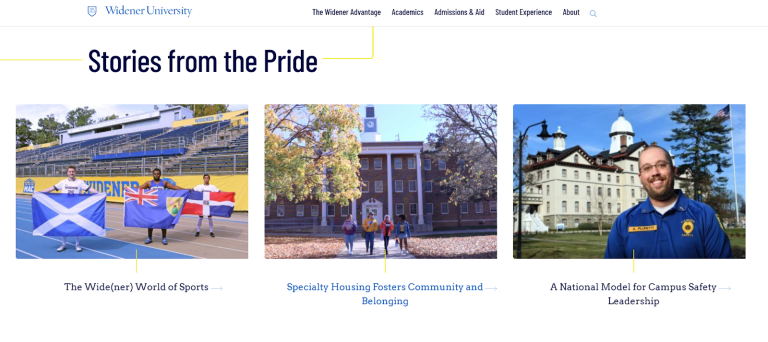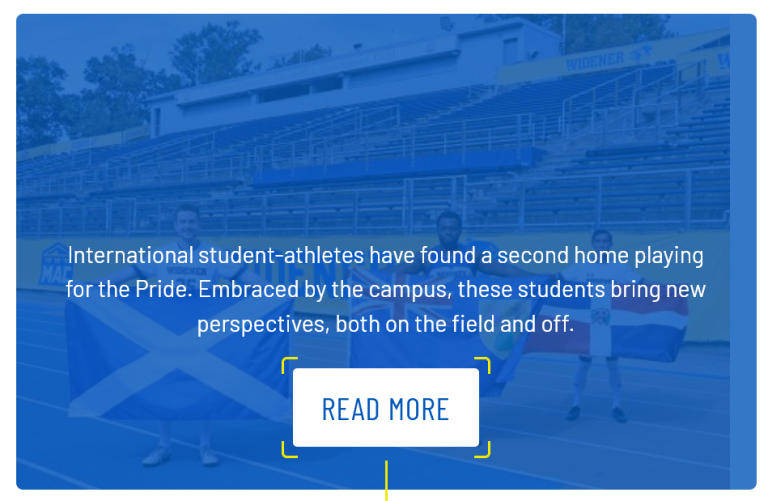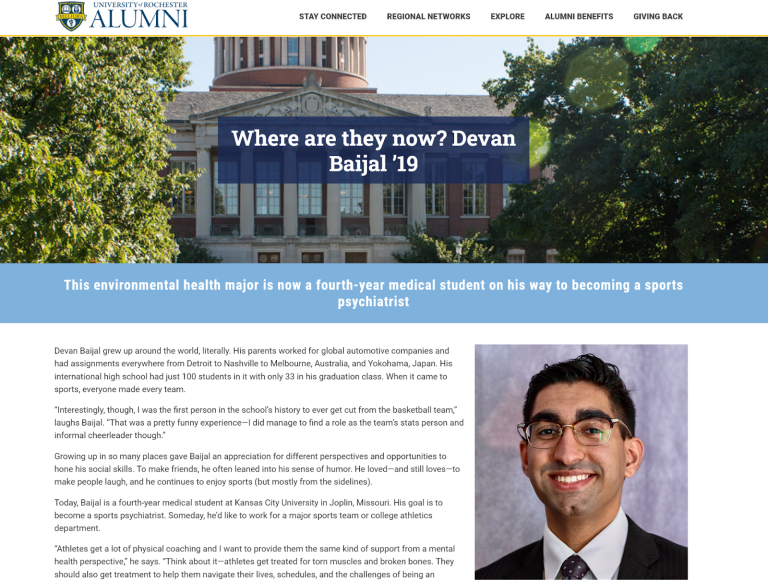
News vs. Stories: What’s the Difference?
News articles and stories are often used synonymously, but the differences between the two are night and day.
Colleges and universities have so much to share, from groundbreaking research to breaking ground on a new student center. But how, where, and why we share information with our audiences can vary. “News” and “stories” may sound interchangeable, but when it comes to web content, there are some key differences.
What is a News Story?
Journalistically speaking, a news story presents newsworthy or previously unknown information in a straightforward, objective way. Straight-up information like this is also referred to as “hard news.”
News stories have their place on higher education websites, but when we talk about news and stories in the context of marketing, we’re mostly likely referring to another type of classification: the feature story. Under the feature umbrella you’ll find profiles, data storytelling, and in-depth human interest pieces.
News & Stories on Higher Ed Websites
Here’s an at-a-glance overview of how we an approach news vs. stories as part of our overall content strategy:
| News informs. | Stories inspire. |
|---|---|
| News is about WHAT a person did recently. | Stories are about a person. The heart of WHO they are. |
| Characteristics | |
|
|
| Higher Education Examples in Action | |
|
|
A Closer Look: Exploring News & Stories Across the Higher Ed Landscape
Here are a few excellent examples of news and feature stories on higher education websites. We selected these not just for how they’re written and visually presented, but also for how they align with institutional goals.
Setting the Expectation, Curating the Experience
A lot of higher education websites do it: Use “Latest News” as the headline preceding a feed of stories. While that approach is accurate and easy, a little extra effort here can make a big difference.
Widener University, for example, labels its homepage news component "Stories from the Pride." This title plays off of the school mascot (a group of lions — and Widener students — is a pride).

This component displays a row of three dynamic story teasers; when you hover over the image, a compelling description appears. The clever “Wide(ner) World of Sports” headline is accompanied by the description: “International student-athletes have found a second home playing for the Pride. Embraced by the campus, these students bring new perspectives, both on the field and off.” This text is custom content, not just the first line or two of the actual story.

When you click through to an individual article, you will see that the official campus news outlet is referred to as Widener Newsroom. This is a reminder that while an internal publication might have a formal name, you can get more creative in how you label those curated experiences — as Widener did with Stories from the Pride, a name that likely has much greater appeal to prospective students.
Showcasing Research Expertise in a Compelling Way
Exciting things are happening in research labs at schools large and small. Technological advancements, new ways of thinking, and discoveries of all kinds are incredible fodder for feature stories. But translating that information into digestible content for everyday readers is challenging.
One way to drill down to the heart of a research story is to ask about the end result: what can this research lead to? What pressing issues does it hope to tackle? These are the types of questions that can turn a jargon-filled scientific headline into a fascinating and accessible story.
Larger research universities already have a good handle on research communications and storytelling, but for institutions without a dedicated research publication or staff science writer, here are a few ways to position research stories.
Updating Existing Stories as Inspiration for New Ones
There are two ways to utilize existing content for fresh ideas. First, you could peruse archives of straight news stories (press releases, announcements, and the like) for interesting headlines that beg the question: “And what happened next?!” That student who won a Fulbright to study ancient Norse mythology? The original news release with a headshot and quote from a proud faculty member served its purpose. Now that the student has returned, what can they share about their academic, research, and cross-cultural experiences? What images did they capture? Not every news release will lead to a feature-worthy story, but there are sure to be a handful of meaningful stories hidden there.
The second option is to look through past alumni or research magazines, web-based profile pieces, or even student-run campus newspapers. What stories are sequel worthy? What might warrant a prequel? For example, say that five or six years ago your admissions website featured a piece on a first-generation college student finding their path forward on campus? Now that they’ve graduated and are continuing their career trajectory, how about a follow-up piece that dives deeper into the first-gen experience. Or, maybe a campaign piece featured a vignette on a golden alumna who endowed scholarship for underserved students; perhaps a passing quote about her childhood could serve as a jumping off point to explore a rich backstory.
To be clear, this idea won’t replace the archived content, but rather be a fresh piece; however, you could absolutely link the two. Here are a few schools have run with this idea recently:
- MIT checked in with nine start-ups founded at the Cambridge-based school
- UC Davis Magazine circled back with about a dozen alumni featured in its page over the decades to create new vignettes
- The University of Rochester’s alumni website has a recurring series of “Where are they now” posts” that feature an in-depth Q&A
- University of Michigan’s School for Environment and Sustainability reflected on a tongue-in-cheek calendar photo shoot and caught up with where those “models” are today
- And, in line with our news theme, Bowdoin University explored the journalism careers of former student reporters at the campus paper The Bowdoin Orient

These are just a few top-level themes to consider for how you find, create, and share news on your college or university website. The ideas are truly endless.
Finding a Home and a Caretaker for Your Stories and News
As with any web content initiative, there’s the question of “Where will this content live?” and “Who is charged with managing the various parts of the storytelling and news-gathering process?”
Depending on the size or structure of your institution, one person or team might be responsible for the news, while another spearheads broader storytelling efforts. Or maybe media relations and marketing efforts are under one roof. Either way, communication and collaboration in these situations is helpful from an overall brand and content strategy standpoint.
A Story Has Many Parts: Additional Technical Considerations
News articles generally originate in one section of a website, such as a “newsroom.” They might be arranged by date as well as be searchable by tag or keyword. However, if you’re really maximizing your website/CMS, individual news items may also appear throughout the website, such as on a related academic department landing page or a transfer student admissions page. Additionally, sharing links on relevant social media outlets can also drive traffic to an individual article.
Stories, however, can usually be sprinkled throughout the site and featured more prominently on top-level pages. Like news items, stories can also be cross-promoted. For example, a story may live in one section, but a promo block on an academic department page might tease that content and then link to a story detail page. And then other similar promotional modules may appear elsewhere on the site, such as the homepage or an admissions landing page.
Another aspect to consider is manual curation vs. automatic feeds of your news stories. If your headline sets the expectation that news is to follow, the content that populates that feed should indeed be news. If we’re not careful about how we tag items — and our overall web governance and content strategy — what appears in homepage news feeds could become a hodgepodge of items.
If storytelling is important to your institution, it’s worth (re)considering the technology and internal practices that drives how content — written, visual, and multimedia — is created, displayed, distributed, and managed. While it will undoubtedly take some legwork up front, you can’t underestimate the power of a good content management system (along with solid taxonomy).
Recap & Next Steps
Whew. We covered a lot of ground in this post. Here’s a quick recap:
What is news? And what is a news story?
News is previously unknown information, and a news story packages that information to an audience in a straightforward way. There’s a difference between hard news and soft news, the latter of which aligns better with higher ed marketing.
How can we “do news” better on higher ed websites?
- Remember that all news isn’t newsworthy
- Think beyond the words; how can visuals and multimedia enhance your stories?
- If publishing content in print and online, maximize headlines for both mediums
- Consider every news release to have future feature story potential
- Mine your archives to find inspiration for new stories; think prequels and sequels!
- Pay attention to the small details like descriptive text that could otherwise autogenerate in no-so-compelling (or safe) ways
- Taxonomy, taxonomy, taxonomy!
OHO specializes in content strategy for higher education. We’d love to talk with you about optimizing your digital storytelling machine (your website) and empowering your storytelling team.
Originally published in April of 2019. Updated June of 2023.